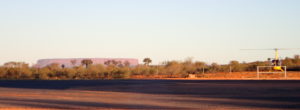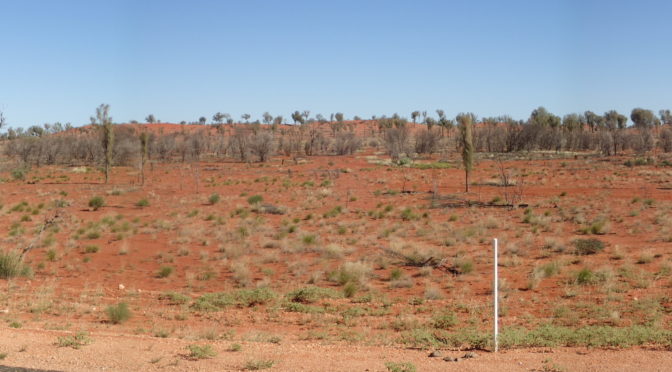Creak and groan! Lethargy develops very quickly once you stop riding. After a slowish rise and pack it was back onto the frog.n.toad.
A headwind combined with rolling sand dunes to make life difficult.
The big change was the transition from mostly natural desert west of Uluru to pastoral country grazed by cattle to the east. While rainfall was increasing the amount of vegetation cover decreased due to the grazing. Very noticeable was how the grazing was managed (I understand it is now based on simulating the episodic heavy grazing experienced by the African savannah under the herds of wilderbeest) – an area/paddock would be grazed almost to the ground then the stock (usually) moved off and the vegetation left to recover rather than being grazed continually at a lower intensity. Seems a more natural system?

Met a lone cyclist (German) and a pair (Italian and English both male) on the road to Curtin Springs. The Italian had ridden from Europe through China. All were wearing the dull grey/brown coloured clothes typical of long-distance cyclists and hated by truck drivers because it makes cyclists hard to pick out in time to make smooth avoiding manoeuvres. The englishman thought it was great that such an old man (me) should be attempting a long distance ride. The cheek!
Curtin Springs station has a free campground with showers for $2. A good deal if basic. Curtin Springs obviously makes its money from the on-site bar and restaurant.
A sideshow is the helicopter rides over Mount Conner. The chopper cranked up to move from the daytime pad to its night park behind the pub while giving the backpacker barmaid a freebie flight.

I am getting too old; the notices on the pub door are more interesting than the tourist sights round about (including the reference that aborigines from a list of communities would not be served as part of a alcohol control agreement with those communities, and the history of the name of Curtin Springs – a dig at the federal government which had broken up the original large cattle stations into smaller units (a socialist action according to the previous owner who had wanted to call the newly reduced block ‘Trotsky Springs’)

